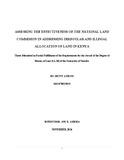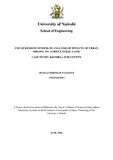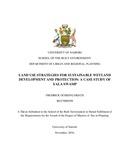Land Library Search
Through our robust search engine, you can search for any item of the over 73,000 highly curated resources in the Land Library.
If you would like to find an overview of what is possible, feel free to peruse the Search Guide.
/ library resources
Showing items 37 through 45 of 269.Participatory mapping is a power tool in resource management. Through this exercise communities are able to identify changes in natural resources and make decision on how best to manage the change.
Resource changes observed in rangeland ecosystems have triggered a myriad of ecological, social and economic dynamics, often with adverse implications on pastoral livelihoods.
In the past mines were abandoned after mining activities leaving undesired effects on the landscape and water sources. Numerous accidents occur in quarries across Kenya leading to deaths of 30 people annually.
Irregular and Illegal allocation of land is a major component of the land question is in Kenya.
The land question is a major rhetoric as it is not one issue but a myriad of issues entrenched in
There has been progress in terms of legislation of land ownership and women rights on the same subject in Kenya and a number of Non-Governmental Organizations and Civil Society Organizations are in the fore front promoting women land ownership.
Land is in no doubt the most important asset in the lives of Kenyans. It is a factor of production which is core to the economic activities of this country. The advent of settlers and colonialism in East Africa placed land in a high level of importance than before.
Urban Sprawl is the spreading out of a city and its suburbs over more and more rural land at the periphery of an urban area. This involves the conversion of rural land into built up, developed land over time. Sprawl is characterised by one or more existing patterns of development.
Kenya has a wealth of wetland ecosystems that support diverse and unique habitats.
This paper discusses the major challenges women in Kenya face as they try to ensure and maintain food security at the household level.







